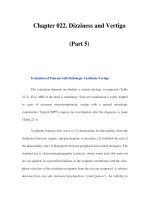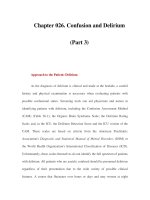Chapter 059. Bleeding and Thrombosis (Part 8) pptx
Bạn đang xem bản rút gọn của tài liệu. Xem và tải ngay bản đầy đủ của tài liệu tại đây (59.15 KB, 6 trang )
Chapter 059. Bleeding and Thrombosis
(Part 8)
Screening Assays
The most commonly used screening tests are the PT, aPTT, and platelet
count. The PT assesses the factors I (fibrinogen), II (prothrombin), V, VII and X
(Fig. 59-6). The PT measures the time for clot formation of the citrated plasma
after recalcification and addition of thromboplastin, a mixture of TF and
phospholipids. The sensitivity of the assay varies by the source of thromboplastin.
To adjust for this variability, the overall sensitivity of different thromboplastins to
reduction of the vitamin K–dependent clotting factors II, VII, IX, and X in
anticoagulated patients is now expressed as the International Sensitivity Index
(ISI). An inverse relationship exists between the ISI and thromboplastin
sensitivity. The international normalized ratio (INR) is then determined based on
the formula: INR = (PT
patient
/PT
normal mean
)
ISI
.
Figure 59-6
Coagulation factor activity tested in the activated partial thromboplastin
time (aPTT) in red and prothrombin time (PT) in green, or both. HMWK, high-
molecular-weight kininogen; PK, prekallikrein; F, factor.
While the INR was developed to assess anticoagulation due to reduction of
vitamin K–dependent coagulation factors, it is commonly used in the evaluation of
patients with liver disease. This measure provides a system for comparing values
from testing performed at different laboratories. However, as progressive liver
failure is associated with variable changes in coagulation factors, the degree of
prolongation of either the PT or the INR only roughly predicts the bleeding risk.
Thrombin generation has been shown to be normal in many patients with mild to
moderate liver dysfunction. As the PT only measures one aspect of hemostasis
affected by liver dysfunction, we likely overestimate the bleeding risk of a mildly
elevated INR in this setting.
The aPTT assesses the intrinsic and common coagulation pathways, factors
XI, IX, VIII, X, V, II, fibrinogen, and also prekallikrein, high molecular weight
kininogen and factor XII (Fig. 59-6). The aPTT reagent contains phospholipids
derived from either animal or vegetable sources that function as a platelet
substitute in the coagulation pathways and includes an activator of the intrinsic
coagulation system, such as ellagic acid or the particulate activators kaolin, celite,
or micronized silica.
The phospholipid composition of aPTT reagents varies, which influences
the sensitivity of individual reagents to clotting factor deficiencies and to
inhibitors such as heparin and lupus anticoagulants. Thus, aPTT results will vary
from one laboratory to another, and the normal range in the laboratory where the
testing occurs should be used in the interpretation. Local laboratories can relate
their aPTT values to therapeutic heparin anticoagulation by correlating aPTT
values with direct measurements of heparin activity (anti-Xa or protamine titration
assays) in samples from heparinized patients, although correlation between these
assays is often poor. The aPTT reagent will vary in sensitivity to individual factor
deficiencies and usually becomes prolonged with individual factor deficiencies of
30–50%. The relationship between defects in secondary hemostasis (fibrin
formation) and coagulation test abnormalities is shown in Table 59-4.
Table 59-4 Hemostatic Disorders and Coagulation Test Abnormalities
Prolonged activated partial thromboplastin time (aPTT)
No clinical bleeding –factors XII, high-molecular-
weight kininogen,
protein kinase
Variable, but usually mild, bleeding –factor XI, mild FVIII and FIX
Frequent, severe bleeding – severe deficiencies of FVIII and FIX
Heparin
Prolonged prothrombin time (PT)
Factor VII deficiency
Vitamin K deficiency – early
Warfarin anticoagulation
Prolonged aPTT and PT
Factor II, V or X deficiency
Vitamin K deficiency – late
Direct thrombin inhibitors
Prolonged thrombin time
Heparin or heparin-like inhibitors
Mild or no bleeding – dysfibrinogenemia
Frequent, severe bleeding – afibrinogenemia
Prolonged PT and/or aPTT not correct with mixing with normal plasma
Bleeding – specific factor inhibitor
No symptoms, or clotting and/or pregnancy loss – lupus anticoagulant
Disseminated intravascular coagulation
Heparin or direct thrombin inhibitor
Abnormal clot solubility
Factor XIII deficiency
Inhibitors or defective cross-linking
Rapid clot lysis
Deficiency of α
2
-antiplasmin or plasminogen activator inhibitor 1
Treatment with fibrinolytic therapy









